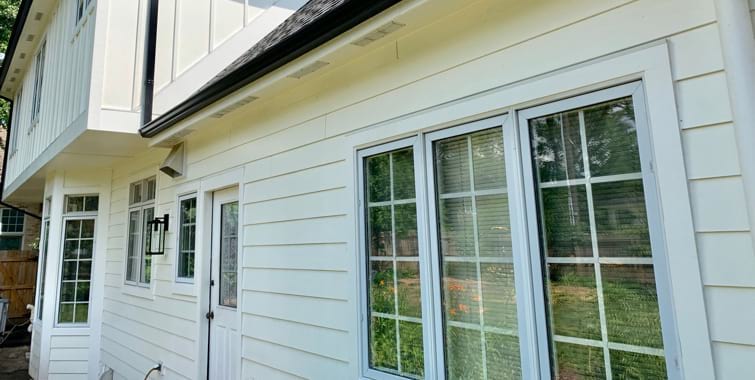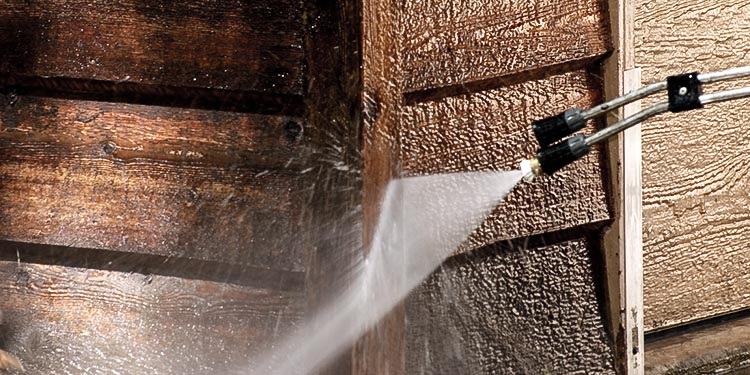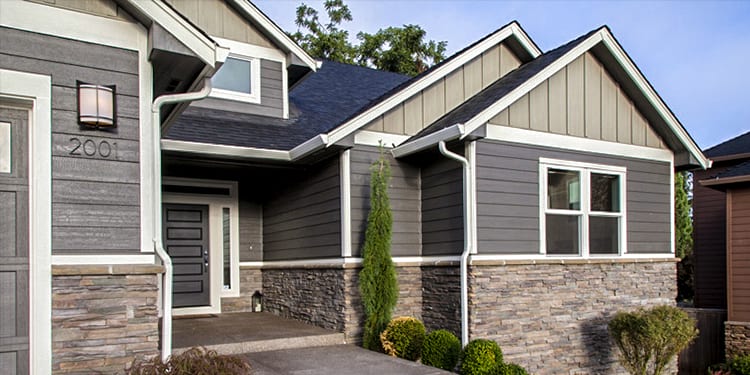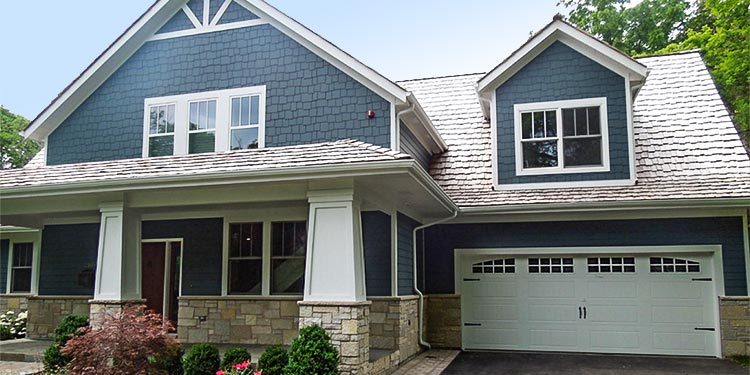How To Clean Your Siding: Vinyl, Cedar, Wood, and Fiber Cement
As the seasons take their toll, subjecting your siding to the scorching heat of summer and the battering winds of debris-filled storms, the need for periodic cleaning becomes inevitable. Whether your siding is crafted from resilient materials like vinyl, cedar, wood, or fiber cement, the accumulated effects of exposure to the elements can lead to a dingy appearance over time. To restore the luster of your home's exterior, regular cleaning is key.

For optimal results, a gentle yet consistent approach is recommended. Sprucing up your siding every 6-12 months with a simple garden hose can work wonders. Contrary to high-pressure power washing, which could potentially damage your siding, a low-pressure hose coupled with a soft-medium bristle brush proves to be the most effective technique for removing dirt and debris from siding surfaces and trim. Whether faced with dirt, grease, or mildew, we've compiled the necessary tools, solutions, and methods to help you maintain the impeccable cleanliness of your siding.
Table of contents:
- WHEN TO CLEAN YOUR SIDING?

- HOW TO CLEAN VINYL SIDING TO REMOVE DIRT AND MOLD

- HOW TO CLEAN CEDAR SIDING AND REMOVE MOLD OR STAINS

- HOW TO CLEAN WOOD SIDING (CARING FOR YOUR LP SMARTSIDE SIDING)

- HOW TO CLEAN FIBER CEMENT SIDING AND MAINTAIN YOUR JAMES HARDIE SIDING

- TAKING THE TIME TO PROPERLY CLEAN AND CARE FOR YOUR SIDING

When to clean your siding?
As homeowners, we encounter a spectrum of common issues that demand thorough cleaning to keep our siding in top-notch condition. In the following exploration, we delve into some of the most prevalent concerns that homeowners often face. These challenges underline the importance of regular cleaning in safeguarding not only the visual allure of our homes but also their structural integrity and longevity.
The following are some of the most common issues homeowners are subjected to that require cleaning:
- Common exposure. UV rays from the sun ranks high as one of the most common exposure concerns for your siding. High winds, rainstorms and winter weather, bird droppings and pollution are also common exposure elements that will affect the look of your siding.
- Mold and mildew. Moisture, whether it is from high humidity, rain or melting snow can lead to mold and mildew issues. Areas of the home that receive less direct sunshine will often be the most affected, as mold and mildew grow more fiercely in these areas.
- Stains. If you see a reddish brown stain on your siding, it could be from rusty nails. Mold, fungus or algae most often cause black and green stains. You’ll find yellow stains on siding where insulation or sheathing behind it has deteriorated. If you have gutter problems, you’ll notice water stains.
- Chalk accumulation. Chalking is a build up of powder usually caused by UV light that reacts with the chemicals in the paint. There are several components that make up paint, and the chalking residue is basically oxidized components of the paint.
- Debris and dirt. Another common problem is debris and dirt that are whipped into the air by winds and accumulate on your siding. It can gather in gaps in the siding and cause streaking stains after a rainstorm.
Knowing what is causing your siding to dilapidated can help you choose the right method for cleaning it and get it back to near its original state.

How to clean vinyl siding to remove dirt and mold
Vinyl siding has grown in popularity over the years because it is less expensive than other siding materials, it is fairly easy to maintain and it comes in a variety of shapes, styles and colors. And while it is easy to maintain, it’s going to become grimy at some point after years of exposure to debris.
There are many ways to clean this type of siding, but the Vinyl Siding Institute advises using a soft cloth or soft-bristle (non-metal) brush.
If your vinyl siding has mildew and/or mold, you’ll need to use a cleaning solution, such as a mixture of water and white vinegar (70 percent water to 30 percent vinegar). But remember, what you put on your siding will end up on the ground, so be sure the chemical you’re using doesn’t kill your landscaping.
Clean vinyl siding without scrubbing
Scrubbing 2,800 square feet of the surface area is not appealing to most homeowners.
Fortunately, there are ways to clean your siding without scrubbing. You can use a pressure washer or a soft-bristled brush attached to a long-handled wand and a container full of cleaning solution attached to a garden hose to apply the solution and knock down the grime.
The non-scrubbing method is best applied to siding that has not accumulated a multitude of grime that is difficult to remove without scrubbing. For example, you can use a “house wash” product, which has a spray nozzle at the end where water and cleaning solution will shoot out of the nozzle with enough pressure eliminate easily removed debris from the siding.
Clean vinyl siding with a pressure washer
Using a pressure washer on vinyl siding can be intimidating due to the fact that some of these washers create a forceful stream of pressure that can damage delicate materials. You will need to lower the pressure on the machine so the water won’t damage the vinyl or get behind it (which can lead to mold, mildew and eventually damage the structures behind the siding).
You should check with your vinyl siding manufacturer to make sure using a pressure washer is safe. After you’ve determined what amount of pressure will work, introduce the cleaning solution to the mix and hold the nozzle at around eye level and at 25 degrees. Standing a few feet away from the area you’re cleaning and make sure you don’t spray in an upward direction, as this will force water behind the siding. Go from the bottom up and use a side-to-side motion. After you’ve pressure washed the house, it is recommended to hose the siding down for a good rinsing.
Clean vinyl siding with bleach
Technically, bleach is a disinfectant, not a cleaner. However, it does remove stains, which is why so many homeowners use bleach to clean their siding. Bleach is an excellent product to use to remove mold, mildew and algae, as it essentially kills these growths and effectively erases any staining left as a result.
There are three common bleach types: oxygen bleach, which contains hydrogen peroxide; bleaching powder, which is calcium hypochlorite and chlorine bleach, which is what you find in products used in the washer to clean clothing. Chlorine bleach is the preferred type for cleaning vinyl siding.
You don’t want to apply bleach directly to the siding without mixing it with water because it can damage your siding. The rule of thumb is to mix a quart of liquid laundry bleach to a gallon of water. If you have landscaping that will be damaged by chlorine bleach, use oxygen bleach, mixing one cup in one gallon of water, as this will be safer for your plants.
Clean vinyl siding with a household cleaner
You don’t have to go out and purchase a bunch of different types of cleaners to take the grime off your vinyl siding – you likely already have what you need in your laundry room. Take a third of a cup of powdered laundry detergent and mix it with one gallon of water. Next, place about 2/3rds cup of TSP cleaner in the mixture. TSP is trisodium phosphate, which is white, granular or crystalline solid an inorganic compound that dissolves in water to produce an alkaline solution. It’s an excellent stain remover and degreaser that will help your laundry detergent and water mixture cut through the toughest grime. Be careful when working with TSP, because it is a toxic substance that must be handled with care because it can be harmful when in contact with skin and to the environment.
How to clean mold off vinyl siding
One of the go-to cleaners for getting rid of mold is a bleach and water solution. The ratio is one quart of bleach per gallon of water. Working from the bottom to the top, use a pump sprayer and wet the siding down. By letting it sit for around 10 minutes, you give the bleach time to work into the mold and kill it. After 10 minutes, use a long-handled, soft-bristled brush to scrub away the mold. With your garden hose, go over all the siding and rinse away the mold and remaining bleach/water solution.
It’s recommended that you use rubber gloves when working with bleach, and make sure your arms are covered and that you’re wearing eye protection.
You can also use a non-toxic product, vinegar, to kill mold on vinyl siding. The ratio in your solution should be 70 percent water to 30 percent vinegar. You can employ similar methods as you do with the bleach solution to treat the siding and get rid of the mold and associated stains.
How to clean vinyl siding without killing plants
If you are concerned that cleaning your vinyl siding with chemicals is going to kill your landscaping, there are ways to prevent plant loss. One is to cover your plants with plastic to ensure no chemicals come into contact with them. However, make sure the runoff doesn’t seep into the ground and affect the roots of the plants.
If you can’t effectively cover your landscaping and/or can’t prevent the cleaning solution from getting into the soil around the plants, use a vinegar solution. Vinegar is fairly inexpensive and is an environmentally safe and extremely effective in cleaning your vinyl siding. Be sure to use the highly acidic white vinegar and mix it with water at a ratio of 70 percent water to 30 percent vinegar.
Simply pour the mixture into the reservoir of your power washer and make sure your pressure is high enough to clean the siding, but won’t damage it.
Wash vinyl siding regularly
Going years between cleanings is a sure way to make it a longer cleaning process than it would otherwise be. With regular cleaning, you can avoid having to work long and hard to get rid of stubborn stains or a massive buildup of mold and mildew.
Most homeowners can get by with cleaning their vinyl siding once a year. But if you have particularly wet and humid summers, you could see a buildup of mold and mildew much faster, which means you need to address the problem the moment you notice it.
Furthermore, if you live in an area where pollution and/or dust is a problem, you’ll likely have to address your cleaning needs on a more frequent basis.
How to clean cedar siding and remove mold or stains
Few siding materials catch the eye like cedar siding. Unfortunately, cedar can become the victim of mildew and mold. A popular method of cleaning it is to use a five-gallon bucket filled with water and mix in some granular oxygen bleach. Manufacturers have different recommendations on the ratio of water to bleach, which means you’ll need to follow the directions on the label.

To begin, saturate the cedar siding and scrub it with a brush and repeat the process until all the mold and associated stains are removed. You might be tempted to use a power washer to make the job go faster, but using this method will force water into places it is not supposed to be, unless you can adjust the pressure to a low setting.
If your cedar siding has an oil-based stain on it, it has been found that this oil will help to feed the mold, which exacerbates the problem. Oxygen bleach is a good chemical to use on this as well. If you’re nervous about the bleach damaging your siding, do a test scrub on a small area, let it dry and inspect the area.
Clean cedar siding with bleach (chlorine bleach and oxygen bleach)
Unlike vinyl siding, you don’t want to use chlorine bleach to clean cedar siding. Chlorine bleach is the traditional and most popular form used in households, most often in the washer to get stains out of laundry. The powerful ingredient is sodium hypochlorite, which is a toxic substance and is not good for your cedar siding, as it can damage the wood fibers.
A more appropriate approach is to use oxygen bleach, the main ingredient of which is sodium percarbonate, which is an adduct of sodium carbonate. Unlike chlorine bleach, this chemical is eco-friendly.
Despite its eco-friendly nature, oxygen bleach will remove algae, mildew and mold from cedar. Mix the powdered form of it with one part to a bucket containing four parts water. You can use a nylon bristle brush to remove the debris from the wood after it has been allowed to soak for around 15 minutes.
Clean cedar siding with pressure washing
While getting the job done right is important, you probably want to also make quick work of the process. Unfortunately, if you don’t have control of the pressure on yours, you’ll need to leave your pressure washer in the garage. If you can adjust your pressure to below 1,000 psi, you can use your washer, but contact your manufacturer first to make sure you have the right settings. With a low-pressure setting, you don’t have to worry about water getting in between the seams and cracks. You also don’t have to worry about creating permanent ruts in your siding.
Use your oxygen bleach mixture in the storage tank on the washer and apply the solution moving from bottom to top. Let it sit for around 15 minutes and go over it again, gently knocking down stains and dead mold. Remember – don’t use chlorine bleach – it will damage the wood fibers and shorten the life of your siding.
How to clean stained cedar siding
As cedar ages, the color changes. For homeowners who don’t like the rustic look, using a stain will keep them happy. Unfortunately, it’s these stains that allow mold and mildew to take hold more rapidly than cedar that has not been stained.
Oxygen bleach is the go-to cleaning product that can mediate your issues. When mixed with water and applied to cedar siding, it can knock down the mold, algae and/or mildew and restore your siding to its original beauty.
Another perk to using oxygen bleach is that it is not toxic like chlorine bleach is. Simply apply the solution to a receptacle attached to a garden hose or to a low-pressure washer apply it to your siding. Allow it to soak for 15 minutes and use a nylon-bristled brush to remove the problem. Be sure to rinse the wood with a garden hose after you’ve scrubbed the siding or power washed it to get all the mold and mildew off.
How to clean painted cedar siding
It’s not what everyone chooses to do, but some homeowners will paint their cedar siding. While it might take away the aesthetically pleasing natural wood look, it will protect the wood fibers from the constant abuse of weather. However, it will collect dirt, dust and grime just like any other type of siding and it needs to be cleaned periodically.
Get started by applying water to your siding. If you’re using a pressure washer, be sure yours has a low setting, because too much pressure can chip the paint and possibly damage the wood fibers. Next, mix a gallon of hot water with three cups of mild dish soap. With a garden hose attached to the receptacle holding the mixture, set it to a light spray setting and mist the solution over your siding. The soap will cut through the grime and begin to break it down.
Next, you’ll want to use a squeegee to wipe the grime off. Don’t use a bristle brush, because that can lead to scratches in the paint. Finally, use plain water to do a final rinse, making sure all the soap and debris is removed.
Clean cedar siding with a household cleaner
Most commercial household cleaners used for cedar siding have oxygen bleach as its active ingredient, but there are also products with hydrogen peroxide as the active ingredient. These types of cleaners offer no chemical odor or fumes and they are safe to use in areas where they will be exposed to plants, grass and trees. Peroxide won’t stain surfaces and it degrades quickly over the course of a few hours.
Cleaners using hydrogen peroxide have been found to brighten the appearance of cedar and do not leave blotchy areas, nor do they bleach out the wood or cause the fibers to become brittle like harsher chemicals might.
Most homeowners using products with hydrogen peroxide will apply it with a garden hose attachment and lightly scrub the cedar, or they’ll use a pressure washer set on low for a no-scrub approach.
Wash cedar siding regularly
Cedar siding is known for being durable and long-lasting, but it is prone to dirt and dust buildup, which needs to be cleaned off periodically. The best approach to making sure your cedar siding looks great and lasts as long as possible is to address problems you spot immediately. You can also mitigate issues like mold and mildew before they become a problem by cleaning it twice per year. You can use a mild soap with water, oxygen bleach or hydrogen peroxide-based cleaners for this twice-yearly task.
Furthermore, you can prolong the life of your siding by making sure your gutters and downspouts are functioning correctly, because introducing regular and prolonged moisture to the material can be detrimental. Inspecting your gutters and downspouts should be an ongoing task, which ensures longer life and better appearance of your cedar siding.
How to clean wood siding (caring for your LP SmartSide siding)
LP SmartSide siding has grown in popularity over the years, because customers are finding it to be easier to install, which reduces labor costs, it’s more impact resistant than other siding materials and it has that desirable wood grain texture. As you might have guessed, LP SmartSide siding also requires cleaning, as it is just as susceptible to the accumulation of grime as other material types.

Using a pressure washer is an efficient way to clean this type of material, but using long-handled, bristled brush is also an option. Applying cleaner to the siding is either done through adding the cleaner of your choice to the pressure washer reservoir or through a garden hose attachment if you’re going that route.
As for cleaners, using oxygen bleach offers excellent results, just make sure you’re not using chlorine bleach, which can negatively impact the color of your siding and kill the landscaping it comes in contact with.
An alternative to oxygen bleach is trisodium phosphate, which should be mixed at a ratio of a half-cup of phosphate to every gallon of water. Finally, make sure your scrubbing brush has soft bristles.
Avoid using a pressure washer to clean LP SmartSide wood siding
Many homeowners avoid using a pressure washer on their LP SmartSide wood siding out of fear that it will damage the material. This type of siding incorporates wood strands coated with wax and bonded with resin and other binders, which is part of what provides that extra layer of impact protection, but using a pressure washer set on high can do plenty of damage to the material. That’s why you should always use a low-pressure setting (below 15,000 psi) with a wide tip, and never get any closer than six feet from the siding.
Clean wood siding with a garden hose
If you’re using a pressure washer, you’ll probably do a final rinse with a garden hose, which won’t damage the siding and washes away all the chemicals. However, you can also buy an attachment with a chemical cleaner that is hooked up to the garden hose and used to distribute the solution on the siding. The pressure from the hose isn’t strong enough to knock down all of the grime, which means you’ll have to use the scrub technique to remove the more stubborn areas of grime.
When using a garden hose, it is recommended to use a solution of water and cleaner, which is often a mild detergent, and scrub the siding with a sponge, cloth or a soft-bristled brush. Be careful not to push too hard with a brush as this can damage the siding. As a final step, use the garden hose (water only) to rinse off any remaining solution and debris.
Spray grimier spots with a wood siding cleaner and brush
Some areas of your siding might be more affected by dirt, mold and mildew, which means the stains will be more difficult to remove. These areas will need more attention, which includes spraying solution on them, letting the solution set for about 15 minutes and scrubbing the area with a cloth or sponge. If you’re using a soft-bristled brush, be sure not to scrub too hard, as this can damage the siding.
If you have a pressure washer set to low, you can treat the more heavily affected areas quickly. Always make sure you’re at a minimum of six feet away from the siding when using a pressure washer, and make sure it’s set at no higher than 1,500 psi.
Clean wood siding with household cleaner and scrubbing by hand
If you have a pressure washer that does not have a low setting, you’ll need to use a household cleaner and scrub the grime off by hand. Start by choosing a cleaner, which is usually a mild detergent mixed in with water in a five gallon bucket. If you’re battling mold and mildew, it’s recommended to use a solution of 75 percent water and 25 percent white vinegar. The vinegar is effective in killing mold and mildew, and it is also helpful in removing stains. Furthermore, vinegar is not toxic, and when mixed with water it will not harm the plants around your house. This is another reason people with landscaping that comes into contact with the solution will use vinegar instead of bleach or detergents.
Use a sponge or cloth to spread the solution over the siding. In areas where the grime is particularly heavy and/or difficult to remove, use a soft bristled brush. Go over the areas as needed until the grime has been removed and rinse with water.
How to clean to remove mold from wood siding
Mold is a common problem affecting siding, especially on areas that receive little to no direct sunlight. Moisture and mold are actually one of the worst problems homeowners with wood siding encounter. If you’ve used a natural oil stain, you will likely have a mold problem at some point, because as the chemicals in the oil breaks down, mold and mildew will grow.
While it might seem like a good mold and mildew deterrent, chlorine bleach can damage your wood siding, which is why you should consider a non-chlorine bleach, like oxygen bleach, which is also more environmentally friendly.
You can also use a solution of 75 percent water to 25 percent white vinegar, which is quite effective in killing mold and removing stains.
Don’t use a pressure washer unless it has a low setting (below 1,500 psi), and keep the nozzle at least six feet from the surface of the siding. Other useful implements include a safe cleaner (generally water mixed with a mild detergent), and a cloth or sponge to spread the solution and scrub out the affected areas.
Wash wood siding regularly
It is recommended to clean your LP SmartSide siding annually. The cleaner the surface of your siding, the less likely it is for mold and mildew to take hold and become a problem.
An annual washing will remove dirt and grime that’s built up over the 12 months and give your wood siding a cleaner, more eye-pleasing appeal. As a preventative maintenance measure, frequently inspect your siding, gutters and downspouts. This allows you to get ahead of issues that can create problems for your siding later. For example, if you have gaps in your gutters, water can leak through to your siding, creating a great environment for mold, mildew and staining. Should you spot a problem that goes beyond your DIY expertise, call a professional to have the situation evaluated.
How to clean fiber cement siding and maintain your James Hardie siding
There are a number of advantages to fiber cement siding, which is why it is becoming a more popular choice for homeowners. James Hardie siding, for example, is a leader in producing this type of siding, which is durable and replaced less often than other types of siding material. It will, however, require minimal upkeep. Dirt, dust, mold and debris should be cleaned as soon as you notice it. This will prolong the life of the siding and give your home more curb appeal.

The James Hardie’s website recommends cleaning off dirt and chalk with water and a soft cloth or soft bristle brush. Wet the cloth or brush as well as the siding, scrub and rinse until clean. For oil, grease and other contaminants, the company recommends a soft cloth, a garden hose and a mild liquid dishwashing soap. Stay away from harsh cleaning chemicals. Frequently rinse your cloth as you clean the siding.
For mold and mildew, James Hardie recommends using a soft cloth or soft sponge, a garden hose and a solution of trusted mildew cleaner, such as those made by Jomax and Armor. Follow the instructions on your mildew cleaner, and make sure to rinse the cleaner off the siding.
Clean fiber cement siding with a garden hose
In some cases, all that’s required to remove dirt and grime from your fiber cement siding is water and a cloth, brush or sponge. You can start by using a soft brush (non-metal) to knock down the dirt and then rinse the surface with a garden hose. Go back over affected areas with your cloth, brush or sponge and rinse again.
If you have a lot of dirt and grime on your siding, you’ll need to switch out your cloth and continually rinse out your sponge or brush so it is free of debris.
For removing oil and grease and other contaminants that require more than water alone, choose a mild detergent, such as dishwashing soap that does not contain bleach, and works it into affected areas with a garden hose attachment. If the stream of soap and water doesn’t completely remove the oil or grease, use a soft cloth to scrub the area until clean – then do a final rinse with water from the garden hose to remove the soap and any remaining debris.
Clean fiber cement siding with mildew-specific cleaner and water
Humid environments are excellent breeding grounds for mildew, which will take hold on your siding and will require a mildew-specific cleaner to remove. Cleaners specifically made for cleaning mildew off of fiber cement siding include products like Jomax, Mildew Check and Mold Armor.
The James Hardie website recommends using a soft cloth or sponge, a garden hose and one of the three cleaners mentioned. Follow the mildew cleaner instructions and lightly scrub the areas where mildew is growing. Use a garden hose to rinse the area and repeat as necessary.
Clean fiber cement siding with pressure/power washing (use caution)
Fiber cement siding is known for its durability and impact resistance, but it doesn’t stand up to high powered pressure washers, which can mar the surface of the siding. Power washers are also known to push water under the siding, which can negatively impact the structures under the siding and lead to bigger problems later, such as rot and staining on the siding.
If your power washer can be set to a psi below 1,500, it is safe to use as long as you attach a wide fan tip and keep the nozzle a minimum of six feet from the surface of the siding. You can also mix in the aforementioned cleaners to assist in removing the grime, then finishing with a water-only rinse.
Taking the time to properly clean and care for your siding
Your siding is the first layer of security on your home. It’s a major component in your home’s curb appeal, which is why taking the time to care for it matters. More importantly, regularly cleaning your siding will protect your home and prolong the life of the siding. At VIS Exterior, we are expert installation, maintenance and repair professionals with years of experience working with vinyl, cedar, LP SmartSide and James Hardie fiber cement siding. For any siding need, we are your go-to siding experts. Contact us and schedule an appointment.













